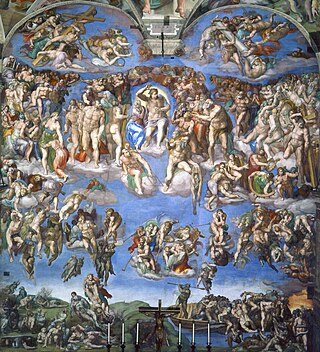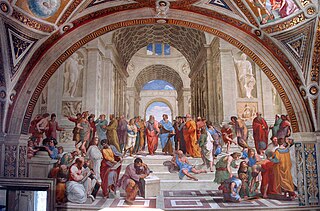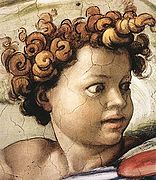
Michelangelo di Lodovico Buonarroti Simoni, known mononymously as Michelangelo, was an Italian sculptor, painter, architect, and poet of the High Renaissance. Born in the Republic of Florence, his work was inspired by models from classical antiquity and had a lasting influence on Western art. Michelangelo's creative abilities and mastery in a range of artistic arenas define him as an archetypal Renaissance man, along with his rival and elder contemporary, Leonardo da Vinci. Given the sheer volume of surviving correspondence, sketches, and reminiscences, Michelangelo is one of the best-documented artists of the 16th century. He was lauded by contemporary biographers as the most accomplished artist of his era.

The Sistine Chapel is a chapel in the Apostolic Palace, the pope's official residence in Vatican City. Originally known as the Cappella Magna, it takes its name from Pope Sixtus IV, who had it built between 1473 and 1481. Since that time, it has served as a place of both religious and functionary papal activity. Today, it is the site of the papal conclave, the process by which a new pope is selected. The chapel's fame lies mainly in the frescoes that decorate its interior, most particularly the Sistine Chapel ceiling and The Last Judgment, both by Michelangelo.

Luca Signorelli was an Italian Renaissance painter from Cortona, in Tuscany, who was noted in particular for his ability as a draftsman and his use of foreshortening. His massive frescos of the Last Judgment (1499–1503) in Orvieto Cathedral are considered his masterpiece.

The Creation of Adam, also known as The Creation of Man, is a fresco painting by Italian artist Michelangelo, which forms part of the Sistine Chapel's ceiling, painted c. 1508–1512. It illustrates the Biblical creation narrative from the Book of Genesis in which God gives life to Adam, the first man. The fresco is part of a complex iconographic scheme and is chronologically the fourth in the series of panels depicting episodes from Genesis.

The Sistine Chapel ceiling, painted in fresco by Michelangelo between 1508 and 1512, is a cornerstone work of High Renaissance art.

Pinturicchio, or Pintoricchio, also known as Benetto di Biagio or Sordicchio, was an Italian Renaissance painter. He acquired his nickname because of his small stature and he used it to sign some of his artworks that were created during the fifteenth and sixteenth centuries.

Sebastiano del Piombo was an Italian painter of the High Renaissance and early Mannerist periods famous as the only major artist of the period to combine the colouring of the Venetian school in which he was trained with the monumental forms of the Roman school. He belongs both to the painting school of his native city, Venice, where he made significant contributions before he left for Rome in 1511, and that of Rome, where he stayed for the rest of his life, and whose style he thoroughly adopted.

The Last Judgment is a fresco by the Italian Renaissance painter Michelangelo covering the whole altar wall of the Sistine Chapel in Vatican City. It is a depiction of the Second Coming of Christ and the final and eternal judgment by God of all humanity. The dead rise and descend to their fates, as judged by Christ who is surrounded by prominent saints. Altogether there are over 300 figures, with nearly all the males and angels originally shown as nudes; many were later partly covered up by painted draperies, of which some remain after recent cleaning and restoration.

The conservation-restoration of the frescoes of the Sistine Chapel was one of the most significant conservation-restorations of the 20th century.

Pope Julius II, commissioned a series of highly influential art and architecture projects in the Vatican. The painting of the Sistine Chapel ceiling by Michelangelo and of various rooms by Raphael in the Apostolic Palace are considered among the masterworks that mark the High Renaissance in Rome. His decision to rebuild St Peter's led to the construction of the present basilica.

Florentine painting or the Florentine school refers to artists in, from, or influenced by the naturalistic style developed in Florence in the 14th century, largely through the efforts of Giotto di Bondone, and in the 15th century the leading school of Western painting. Some of the best known painters of the earlier Florentine School are Fra Angelico, Botticelli, Filippo Lippi, the Ghirlandaio family, Masolino, and Masaccio.

The Sistine Chapel ceiling, painted by Michelangelo between 1508 and 1512, is one of the most renowned artworks of the High Renaissance. Central to the ceiling decoration are nine scenes from the Book of Genesis of which The Creation of Adam is the best known, the hands of God and Adam being reproduced in countless imitations. The complex design includes several sets of individual figures, both clothed and nude, which allowed Michelangelo to fully demonstrate his skill in creating a huge variety of poses for the human figure, and have provided an enormously influential pattern book of models for other artists ever since.

The Crucifixion of Saint Peter is a fresco painting by the Italian Renaissance master Michelangelo Buonarroti. It is housed in the Cappella Paolina, Vatican Palace, in the Vatican City, Rome. It is the last fresco executed by Michelangelo.

Hendrick van den Broeck or Arrigo Fiammingo was a Flemish painter, fresco painter, glass painter and sculptor of the late-Renaissance or Mannerist period. After training in Flanders, he travelled to Italy where he remained active in various cities for the remainder of his life. He was court painter to Cosimo I de Medici in Florence and worked as a fresco painter in Rome on the large decorative projects of pope Gregory XIII.

The Prophet Isaiah is a fresco located in Basilica di Sant'Agostino, an early Renaissance church in Rome. It is an Italian Renaissance painting, influenced by Michelangelo's work on the Sistine Chapel ceiling.

The Separation of Light from Darkness is, from the perspective of the Genesis chronology, the first of nine central panels that run along the center of Michelangelo's Sistine Chapel ceiling and which depict scenes from the Book of Genesis. Michelangelo probably completed this panel in the summer of 1512, the last year of the Sistine ceiling project. It is one of five smaller scenes that alternate with four larger scenes that run along the center of the Sistine ceiling. The Separation of Light from Darkness is based on verses 3–5 from the first chapter of the Book of Genesis:

The Prophet Jonah is one of the seven Old Testament prophets painted by the Italian High Renaissance master Michelangelo on the Sistine Chapel ceiling in the Vatican Palace of Vatican City.

The Prophet Jeremiah is one of the seven Old Testament prophets painted by the Italian High Renaissance master Michelangelo on the Sistine Chapel ceiling. The Sistine Chapel is in Vatican Palace, in the Vatican City.

The Prophet Daniel is one of the seven Old Testament prophets painted by the Italian High Renaissance master Michelangelo on the Sistine Chapel ceiling. The Sistine Chapel is in Vatican Palace, in the Vatican City.

The Prophet Joel is one of the seven Old Testament prophets painted by the Italian High Renaissance master Michelangelo on the Sistine Chapel ceiling. The Sistine Chapel is in Vatican Palace, in the Vatican City.






















